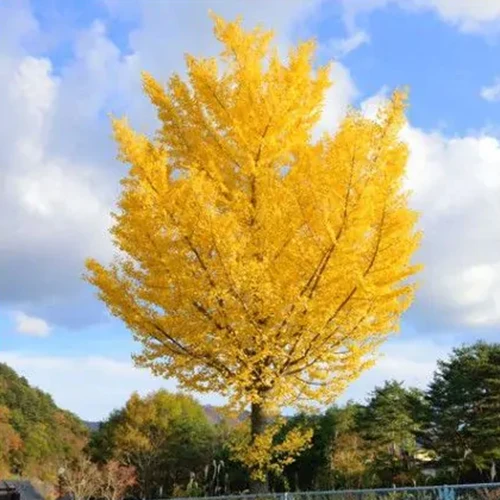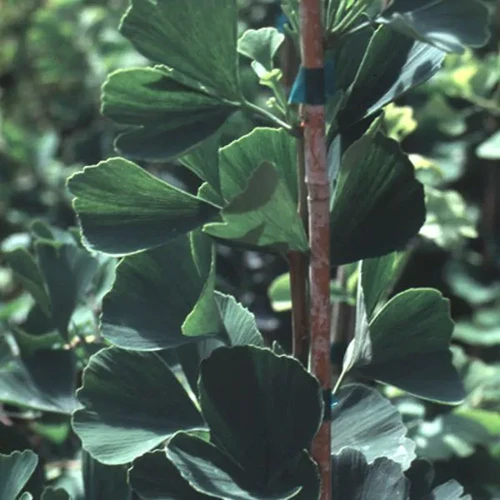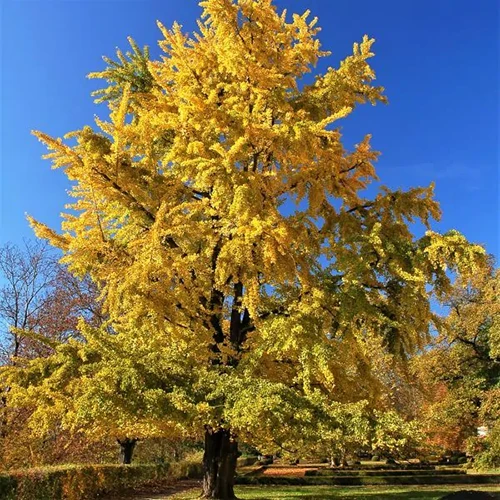Variety is the spice of life, and cultivated varieties are the spice of landscaping.
Like the taste of Old Bay Seasoning on shrimp, finding the right ginkgo cultivar for your property can really hit the spot.
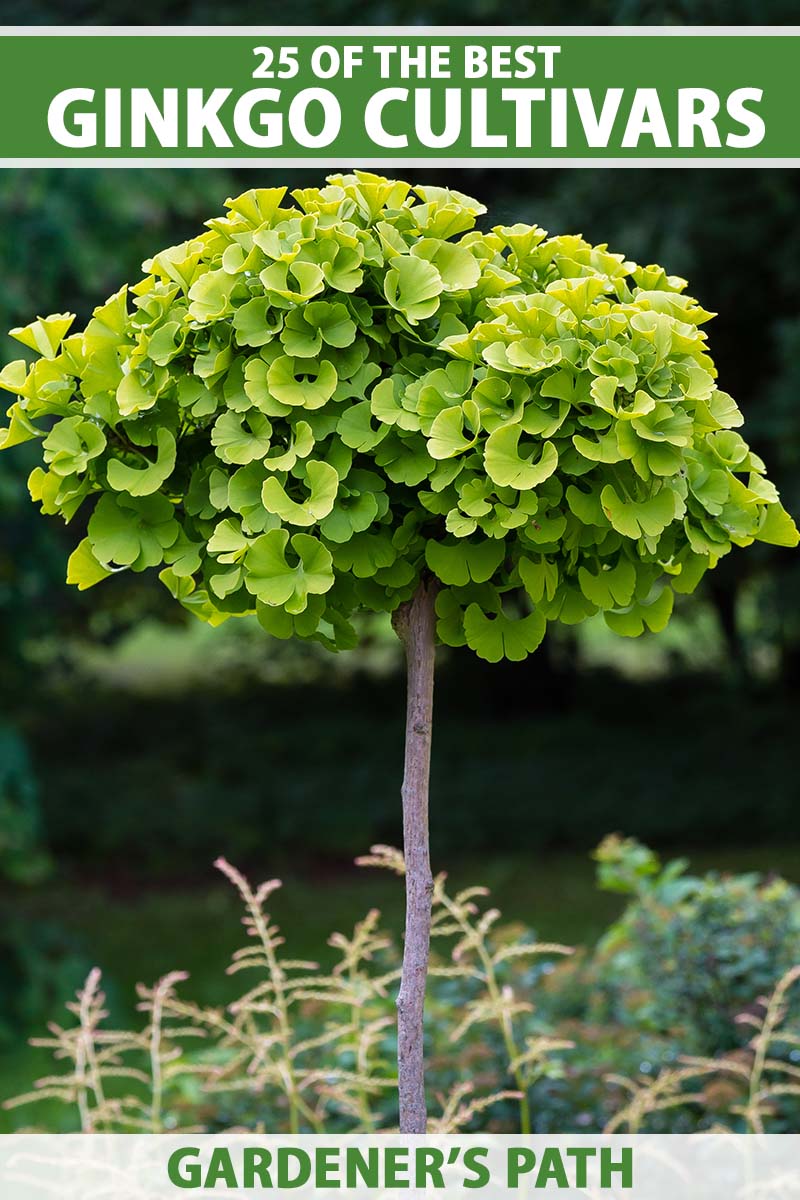
We link to vendors to help you find relevant products. If you buy from one of our links, we may earn a commission.
A standard Ginkgo biloba is certainly quite aesthetic as is, no variation required.
But if you’re looking for unique foliage, dimensions, or growth habits, you may want to look beyond your everyday ginkgo tree.
But you won’t have to look very far, as G. biloba offers a plethora of ornamental variation.
With hundreds of cultivars to consider, a gardener may be faced with a difficult decision. How will you determine which variety to pick?
No one can tell you exactly which one is best… after all, you’ll have to decide based on your own needs in the landscape. Your selection should be the right fit in terms of preferred size, form, and other qualities.
But once you’ve assessed your space and figured out your design needs, our guide to 25 of the best Ginkgo cultivars is sure to make your choice a bit easier.
Here’s the list of contenders, in alphabetical order for your browsing convenience:
25 of the Best Ginkgo Varieties
Before we dive in, you should definitely have an idea on the sort of tree you’re looking for and where you want to plant it.
It wouldn’t really make much sense to place a dwarf tree in the middle of your vast front yard, nor would you want a full-sized specimen to go where a compact one would be more suitable.
If you need a last-minute reminder of what the standard species is like or you’re looking for cultivation tips, check out our G. biloba growing guide.
Now, onto the trees!
1. Autumn Gold
A solid entry to start off our list, ‘Autumn Gold’ is a conical tree that tends to broaden with age, reaching mature heights 50 feet and widths of 30 feet.
Introduced in California by breeders at the Saratoga Horticultural Foundation circa 1955, this male, fruitless cultivar exhibits a broadly-spreading crown with gorgeous symmetry, and its foliage turns a stunning golden yellow in fall.
Autumnal beauty, fabulous uniformity… you can’t go wrong with ‘Autumn Gold.’ It’s available for purchase from Nature Hills Nursery.
2. Chase Manhattan
Despite its name, ‘Chase Manhattan’ was actually discovered in Anna, Illinois by J. Bon Hartiline.
Also known as ‘Bonn’s Dwarf,’ this compact male cultivar has a uniform and conical habit, and can be expected to reach heights and spreads of three to five feet after 10 years of slow growth.
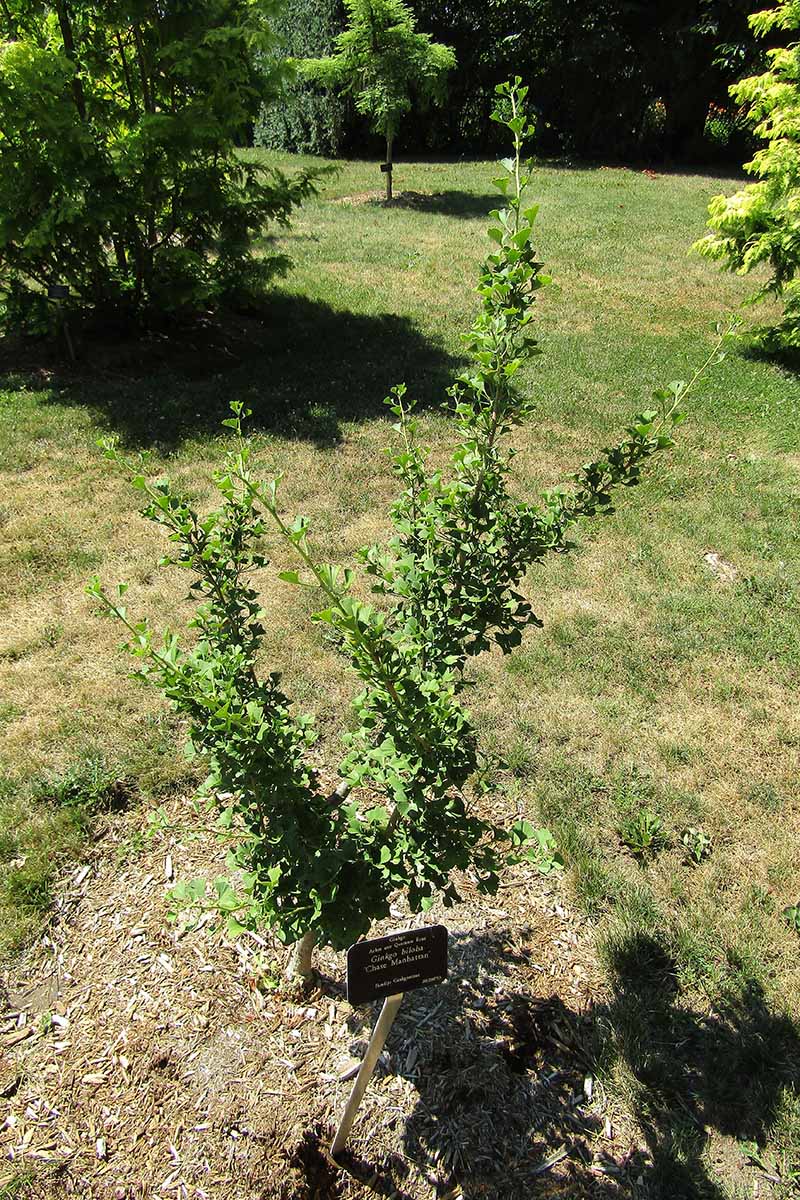
The itty-bitty size of ‘Chase Manhattan’ also carries over to its leaves, which are about 10 to 15 percent the size of standard ginkgo foliage.
The miniature leaves have the slightest upward arch and toothed margins to them, and are a bit darker than usual, too. Little in physical stature, yet big in visual impact.
3. Chi-Chi
A densely-growing and multi-stemmed shrub variety, the dwarf ‘Chi-Chi’ cultivar sports a fan-shaped habit that tends to reach four to five feet in both height and spread over about a 10-year period.
The leaves turn a stunning yellow come fall, and are slightly smaller than those of the standard species.
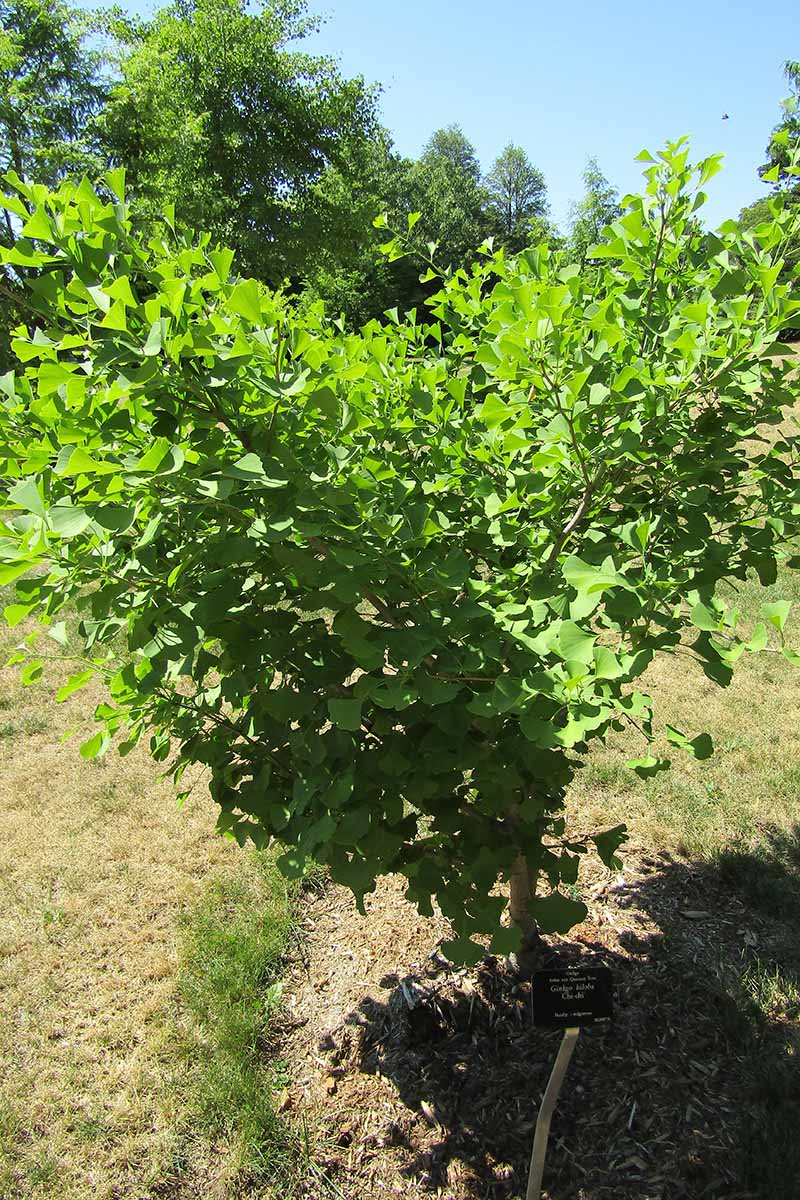
As the plant matures, dormant buds swell on the plant’s trunk and branches, with an appearance a bit reminiscent of breast tissue… which isn’t merely a juvenile observation, but rather the actual inspiration for the name ‘Chi-Chi,’ which is Spanish slang for “breast.”
Unusual etymology to touch on, no doubt. But “unusual” is certainly a positive attribute of ‘Chi-Chi,’ a male cultivar that’s simply a must for any die-hard ginkgo collector.
4. DJ’s Bow Tie
Some cultivar names are catchy or regal-sounding, yet they don’t convey much information. Others, like ‘DJ’s Bow Tie,’ give you a pretty good hint as to what you’re dealing with.
From the curved horizontal branches of ‘DJ’s Bow Tie’ grow deep green, nearly-blue leaves that are variable in shape.
Some are broadly divided and easily recognizable as ginkgo leaves. Others are so evenly divided that they resemble bow ties, albeit botanical ones.
This upright, narrow-growing cultivar can reach heights of three to six feet at maturity. Honestly, its bow tie-esque foliage alone warrants the plant’s addition to your landscape.
5. Emperor
Identified by Berthold Nursery and introduced by Chicagoland Grows, ‘Emperor’ will almost make you bow in reverence to its majesty.
A strong central leader and uniform oval shape, plus mature heights and widths of 50 and 30 feet, all add up to command respect.
During its youth, the tree has a central leader that’s just a bit floppy. But just as a ruler must grow into their role, a young ‘Emperor’ will eventually grow into its upright splendor.
This sterile male cultivar also goes by the name ‘Woodstock.’
6. Fairmount
Selected from a tree in Philadelphia’s Fairmount Park, ‘Fairmount’ is a male clone that is quite tall, yet quite narrow.
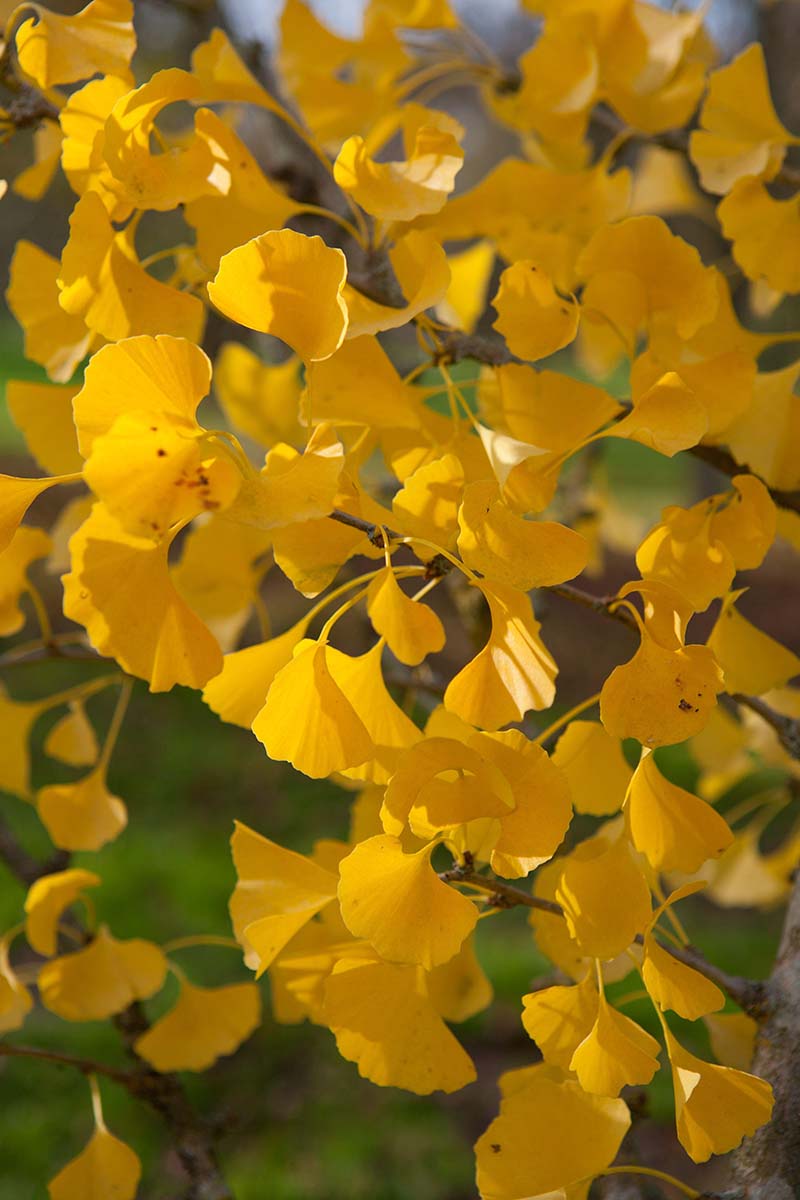
With a mature height of 75 feet and a spread that’s about a third that, this skinny cultivar has the densely-packed foliage and pyramidal shape to provide ample shade in tight planting spaces!
7. Fastigiata
Fastigiate or columnar and upward-branching ginkgo forms, sometimes referred to under the umbrella of ‘Fastigiata,’ grow to be 30 to 50 feet tall with a spread of 10 to 15 feet.
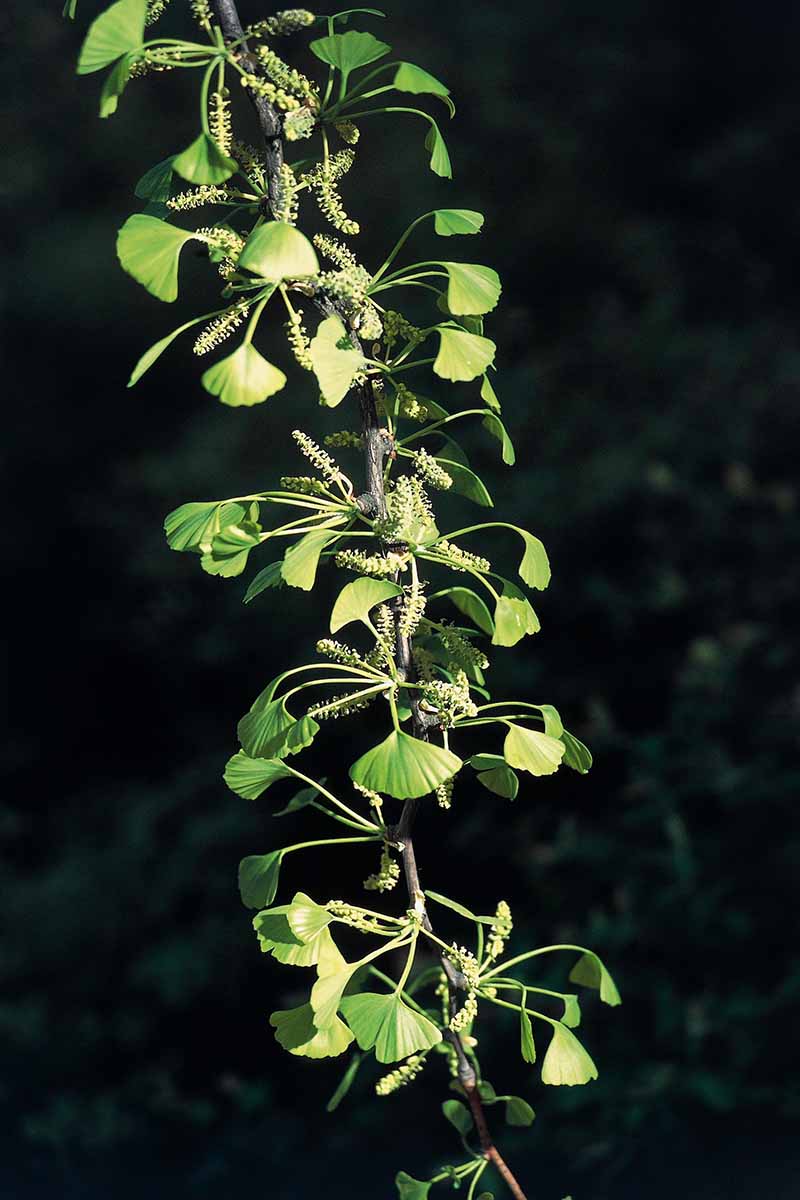
Male, female, and sterile plants of this variety are available from nurseries.
All in all, if you want a slightly smaller version of ‘Fairmount,’ then ‘Fastigiata’ is the perfect choice.
8. Golden Colonnade
Also known by the less marketable, Star Wars-sounding name ‘JFS-UGA2,’ ‘Golden Colonnade’ is a sterile male variety that was introduced by Oregon’s J. F. Schmidt & Son Co.
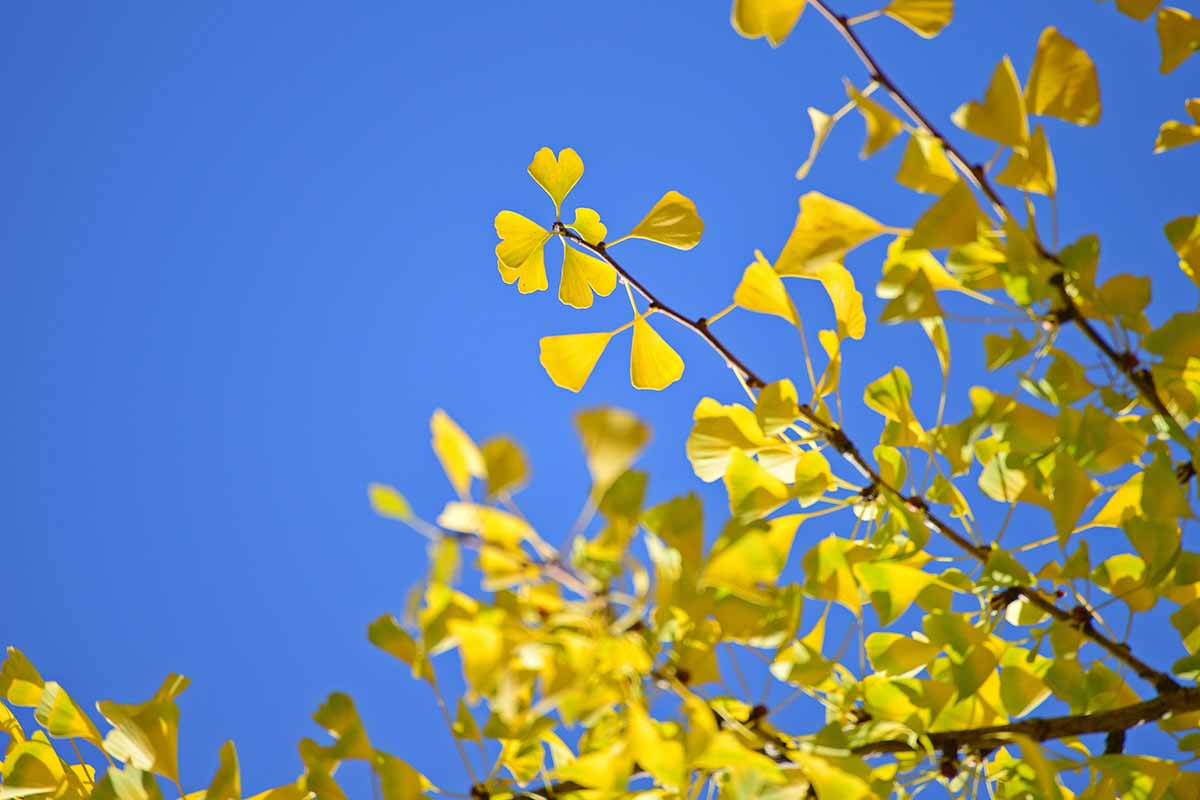
With mature dimensions of about 45 feet in height and 25 feet in width, ‘Golden Colonnade’ has a narrow, columnar, and oval-shaped habit.
Branches and stems jut upwards at a 45-degree angle from the trunk and larger branches, and the densely-growing, medium green foliage turns light yellow in fall.
9. Golden Globe
Continuing with the aureate aesthetic, ‘Golden Globe’ was discovered as a seedling in Fort Valley, Georgia in 1990 and later introduced by Cleveland Tree Farms.
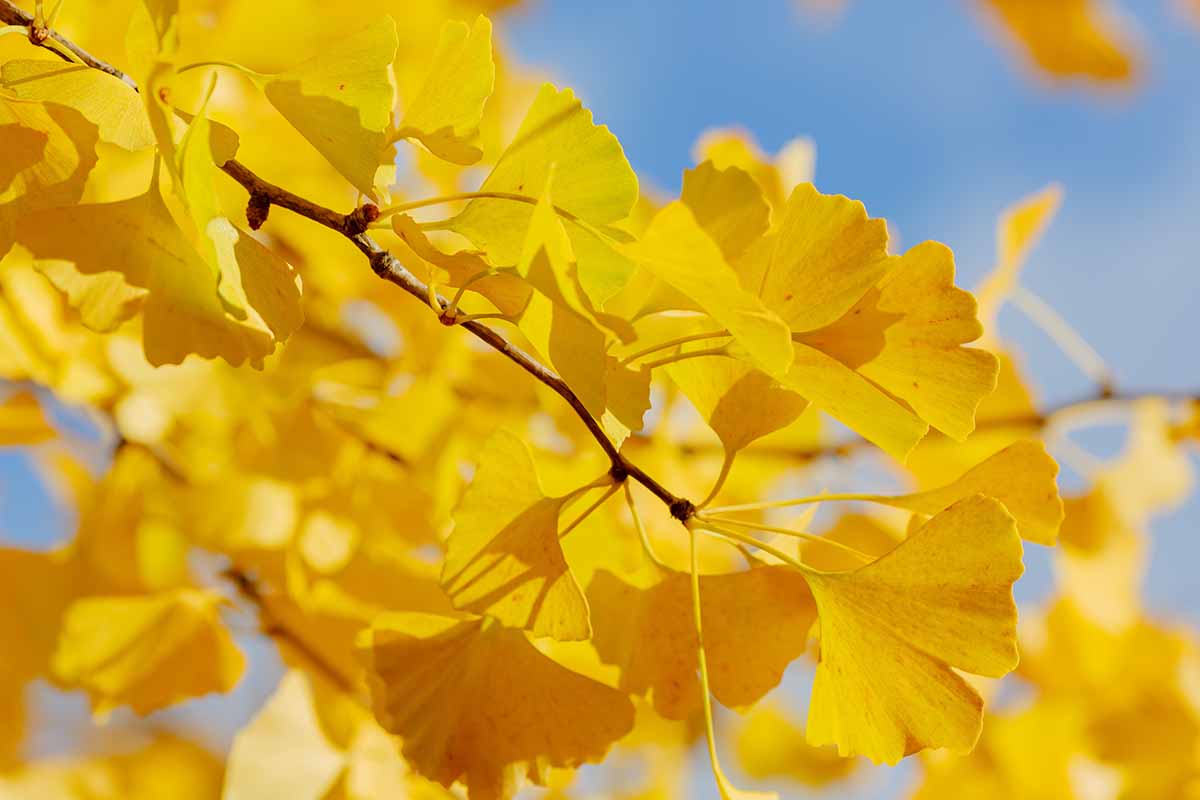
A fast-growing male cultivar that develops a full, dense crown at a young age, ‘Golden Globe’ reaches 40 to 50 feet in height with a 30- to 35-foot spread.
With lovely yellow foliage in fall, ‘Golden Globe’ is an incredible selection if displaying autumnal golden hues in a rounded shape is the goal.
10. Gresham
A horizontally-branching version of the standard species, ‘Gresham’ was discovered at Gresham Union High School in Gresham, Oregon.
And when I say “horizontally-branching,” I mean it: they literally jut out at about a 90-degree angle from the trunk a ways before tapering upward.
This male tree has an annual growth rate of about eight to 16 inches.
As a whole, ginkgoes aren’t the most climbable of trees. But with the proper pruning and enough time, a mature ‘Gresham’ can practically act as a jungle gym.
11. Halka
Eventually attaining mature heights of 45 feet and spreads of 40 feet, ‘Halka’ has a form that’s essentially perfectly round in shape, with symmetrical branching.
All in all, ‘Halka’ is a fantastic choice for when you want a sterile male cultivar that is quite pleasing to the eye.
12. Jade Butterfly
‘Jade Butterfly’ is a dwarf cultivar that reaches heights of 12 to 15 feet and widths of six to 10 feet, but that’s not what earns this sterile male ginkgo its fame.
That honor goes to its leaves, which are deeply notched and reminiscent of pale green butterflies.
On top of the Lepidoptera theme that the leaves have going on, ‘Jade Butterfly’ wields a slow growth rate and an upright, vase-shaped form.
For a collector of plants with fun foliar shapes, you won’t want to miss out on this one.
For a ‘Jade Butterfly’ or two of your own, head on over to Nature Hills Nursery.
13. Liberty Splendor
A conical tree shape is quite lovely, especially when it’s paired with ginkgo foliage – and ‘Liberty Splendor’ rocks both.
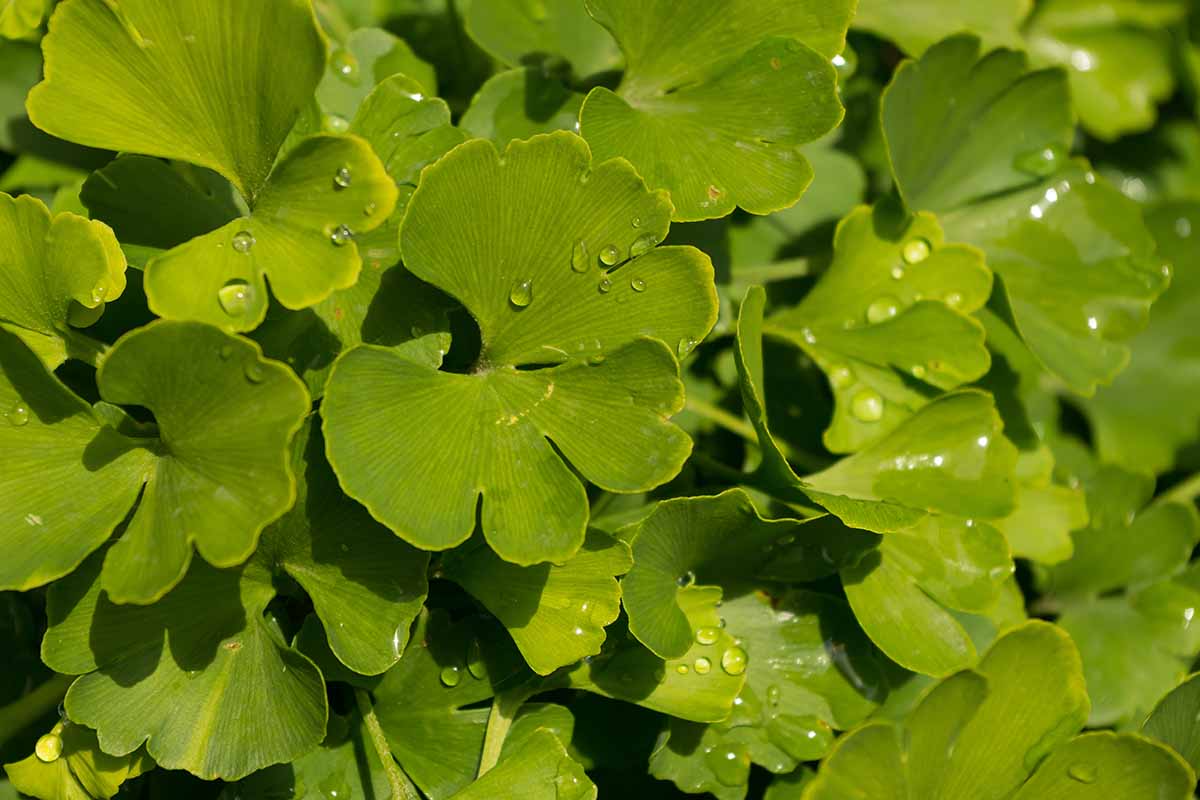
With a mature height and width of 40 to 50 feet, the female ‘Liberty Splendor’ was introduced by ArborVillage in Holt, Missouri (whoop-whoop!) as a pyramidal powerhouse.
And I can’t forget to mention the golden fall foliage, which just sweetens the deal all the more.
14. Magyar
Introduced by Princeton Nursery, ‘Magyar’ is a columnar, upright-branching male cultivar with a uniform symmetry that’s quite attractive.
With a mature height of 60 feet and a spread that’s about half that, ‘Magyar’ is another classy planting for less-than-wide-open spaces.
15. Majestic Butterfly
Cultivars with butterfly-shaped leaves are too pretty to hype up just one of ’em. ‘Majestic Butterfly’ is actually a mutation of ‘Jade Butterfly’ that has since been cultivated.
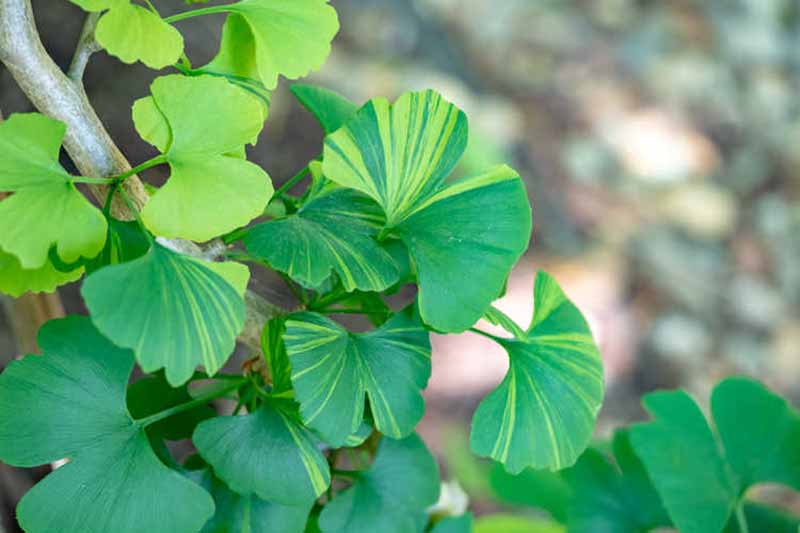
Discovered by Crispin Silva, ‘Majestic Butterfly’ has similar leaves to its predecessor, save for a forest green hue and cream- to yellow-colored streaks of variegation.
This male cultivar should grow to be six feet tall and nine feet wide in 10 years’ time, although the plant’s vigor is usually inversely proportional to how variegated it is.
Regardless of how long it takes, a fully grown ‘Majestic Butterfly’ is well worth the wait!
16. Mayfield
A 1948 selection from Ohio, ‘Mayfield’ is a male clone that can reach heights of 15 and widths of four feet in 10 years’ time, while its mature dimensions are double that.
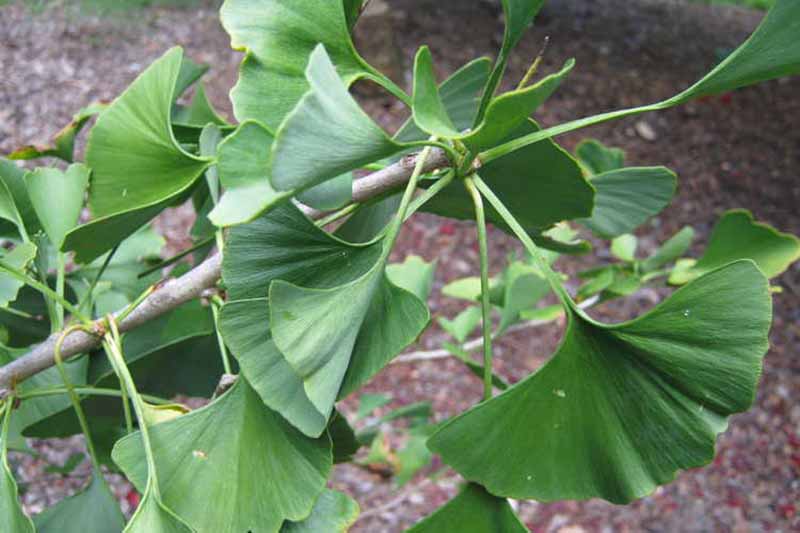
The narrowest cultivar on our list thus far, ‘Mayfield’ is a mid-sized beauty that’s perfect for tight spots in the landscape.
17. Munchkin
Also known as ‘Chris’s Dwarf’ – the selection that ‘Munchkin’ was derived from – ‘Munchkin’ holds the title for “smallest dwarf ginkgo foliage.”
Said leaves are a quarter the standard size, with a width of one mere inch.
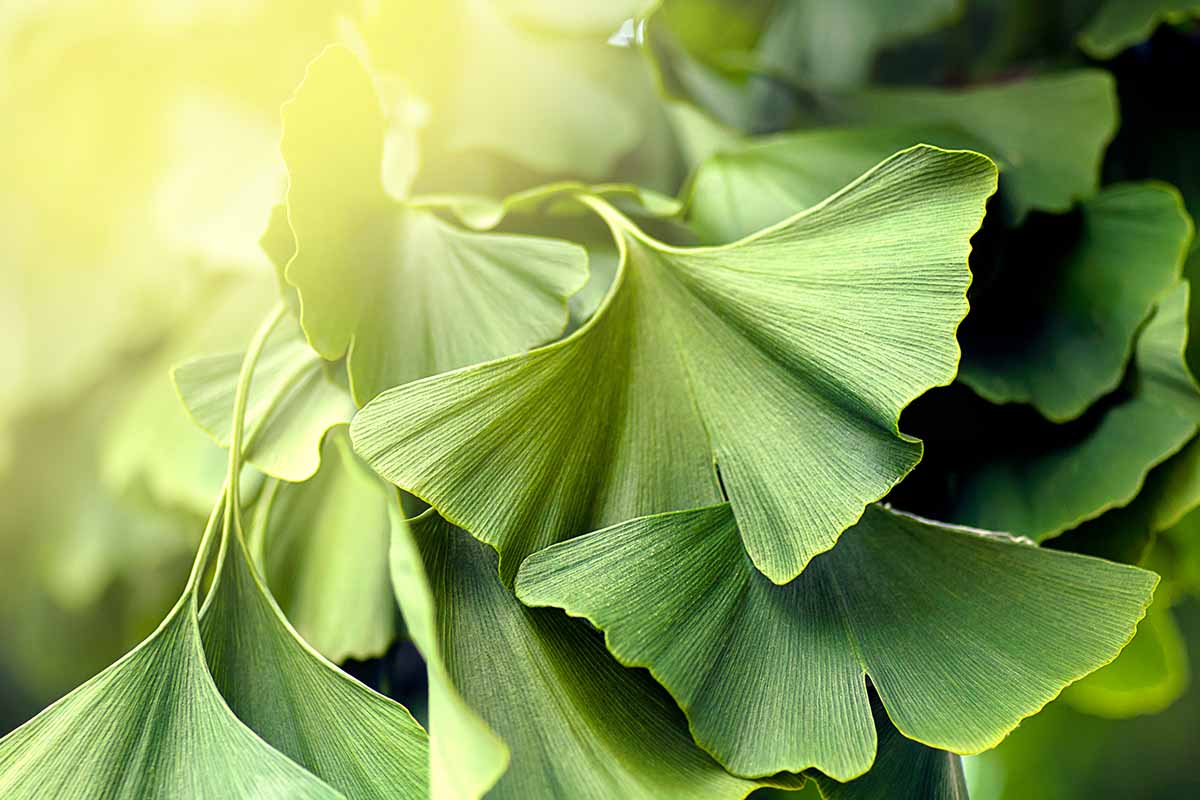
The small leaves of this male clone give the branches a bit of a twiggy appearance.
With a height of two to three feet and a rounded, yet irregularly-shaped habit, the ‘Munchkin’ cultivar is simply adorable.
18. Presidential Gold
Selected from in front of the University of Georgia’s Presidential residence by the legendary plantsman Dr. Michael A. Dirr, ‘Presidential Gold’ – aka ‘The President,’ epically enough – is a sterile male clone that is well known for its especially dense branching.

At a mature height of 50 feet with a spread of 40 feet, ‘Presidential Gold’ has wide, yet upward-angled branches, and beautiful, golden fall hues to boot.
Hopefully, you will “elect” to plant the upright ‘Presidential Gold’ somewhere in your landscape.
19. Princeton Sentry
If you’re at all familiar with the Ivy League, “Princeton” is a name that holds weight. In the world of ginkgo cultivars, ‘Princeton Sentry’ is also quite well-renowned.
This male cultivar reaches heights of 40 to 60 feet and spreads of 15 to 25 feet, with a pointed apex that broadens out towards the base.
This aesthetic conical form also comes with pleasant yellow foliage in autumn. All in all, a prestigious planting.
‘Princeton Sentry’ can be purchased from Nature Hills Nursery.
20. Santa Cruz
Just like an umbrella may come in handy on a Santa Cruz beach, the umbrella-shaped form of ‘Santa Cruz’ could also be useful in your sunny landscape.
‘Santa Cruz’ initially grows upright during its youth, then spreads out wide with maturity.
This fruiting female’s umbrella-like shape is very distinct and attractive, especially with its fully grown dimensions of 15 feet in height and 20 feet in spread.
21. Saratoga
Another introduction by the Saratoga Horticultural Foundation in 1975, the male ‘Saratoga’ cultivar has a similarly symmetrical and broad-spreading crown as ‘Autumn Gold,’ albeit with a slightly reduced height of 40 feet.

Plus, its stunning leaves resemble a fishtail palm in narrowness.
If you thought that your ‘Autumn Gold’ was a tad too tall and stereotypically-leaved, ‘Saratoga’ is a delightful alternative.
22. Shangri-La
Patented by Willet N. Wandell in 1984, ‘Shangri-La’ is a rapidly-growing male cultivar that reaches heights of 55 to 40 feet and spreads of 40 to 30 feet.
With a pleasantly-rounded habit and balanced crown, ‘Shangri-La’ offers many picturesque possibilities in the landscape.
23. Sunstream
‘Sunstream’ definitely lives up to its name via its foliage, which sports irregular stripes of yellow variegation.
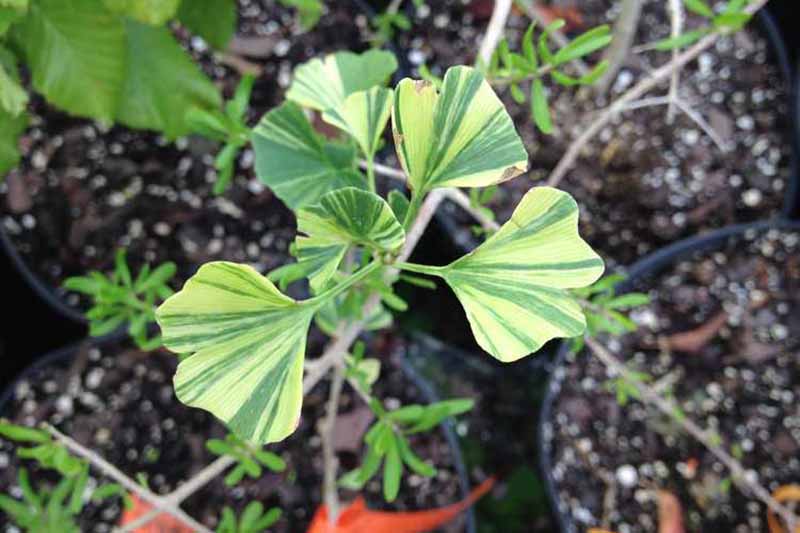
As the leaves mature, they tend to take on a creamier hue. And as an overall plus, this male variety isn’t as likely to revert to all-green as other variegated types might.
With a mature height of eight feet or so and a slightly broader growth habit, ‘Sunstream’ is the perfect choice for those who can’t decide whether green or yellow ginkgo leaves are their favorite.
24. Weeping Wonder
Known as ‘Mutant Weeper’ across the pond in Europe, ‘Weeping Wonder’ is another cultivar worth growing for its visual uniqueness.
This shrub-sized female cultivar reaches mature heights of 10 feet and widths of six feet, and has a distinctly weeping form that sets it apart from other ginkgos.
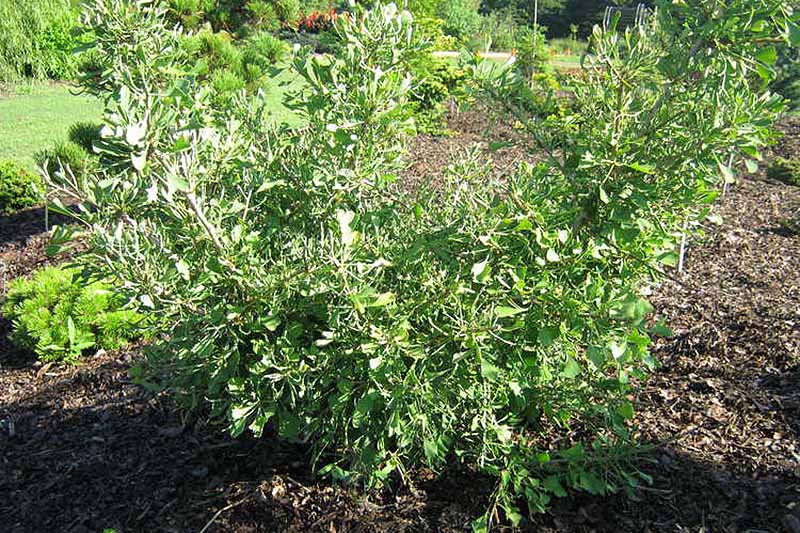
The leaves are all over the map, so to speak.
While a few are fan-shaped as is typical, and moderately divided the rest exhibit varying shapes and degrees of division, raggedness, and fraying.
The best way of describing the foliage has already been uttered by woody plant expert Dr. Michael A. Dirr: it “appears to have been put through a paper shredder.”
Some may say “oooh” and “ahhh,” while others might not be as impressed. But there’s no denying that ‘Weeping Wonder’ will make you do a double-take.
25. Witch’s Broom
‘Witch’s Broom,’ or ‘WB,’ is a male cultivar that was taken from a ginkgo’s actual “witch’s broom” deformity.

Reaching a mature height of eight feet with a spread of six feet, this cultivar has a globular habit and an annual growth rate of two to four inches. Small, spherical, and quite spectacular.
With Great Varieties Come Great Possibilities
It’s true – if you have the right cultivars, you’ve got a ton of amazing options for planting.
Small or large, round or conical, and with standard foliage or zany leaves… if your landscape has a need, there’s a ginkgo for the job!

Or maybe you’re a completist by nature, and the thought of just having one or two varieties leaves you wanting. I can empathize, believe me.
With enough space, cash, and time, a gardener could have a living museum of Ginkgo cultivars on their hands.
Have any unanswered questions? Thought I left a contender out? The comments section is ready and waiting.
Want some more deciduous landscape tree roundups? Give these a read next, all wrangled up nicely for ya:
